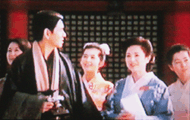

Released: 1983
Length: 140 minutes
Producer: Toho
Director: Kon Ichikawa
Screenplay: Kon Ichikawa/ Shinya Hidaka
Cinematographer: Kiyoshi Hasegawa
Music: Shinnosuke Okawa/Toshiyuki Watanabe
Cast:
Tsuruko (eldest sister)................................................................................Keiko
Kishi
Sachiko (second sister)......................................................................Yoshiko
Sakuma
Yukiko (third sister)..........................................................................Sayuri
Yoshinaga
Taeko (youngest sister)......................................................................Yuko
Kotegawa
Tatsuo (Tsuroko's husband)........................................................................Juzu
Itami
Teinosuke (Sachiko's husband)...............................................................Koji
Ishizaka
Hashidera.....................................................................................Toshiyuki
Hosokawa
Story:
The film spans a period of approximately three years,
from 1938 into 1941, coinciding with Japan's initial military successes
in China to the eve of war with the United States. But the film is not
about the war, except indirectly. Instead it focuses on the lives of the
four Makioka sisters, the surviving daughters of a prominent merchant family.
Most particularly, the film revolves around the search to find a suitable
husband for the third sister (Yukiko) through the traditional method of
arranged marriage (omiai) and the youngest daughter's (Taeko's)
headstrong efforts to make her own choices against traditional values.
Commentary:
Ichikawa's film is based on Junichiro Tanizaki's wartime novel, the The Makioka Sisters, although it is not entirely faithful to Tanizaki's plot. Elements of the novel are omitted, emphasized, or rearranged where Ichikawa thinks this makes the film work better as a film.
The film's central theme is the same as the novel, however: It's about the conflict between vanishing traditional Japanese ways and an emerging Japan that is an amalgam of those ways and western influences. The elder Makioka sisters represent the past, especially in their search for a husband for Yukiko, who by tradition must marry before the youngest sister, Taeko. Takeo represents the future, seeking as she does to make her own marriage and use the money which has been set aside for her dowry to start a doll-making business.
The film is exquisitely beautiful and somewhat reminiscent of the Merchant Ivory chronicles of upper-class British families. Ichikawa uses changing seasons and changing locales to reflect the erosion of tradition and changing social values in Japanese society. For instance, the film opens with a gorgeous scene of the Makioka family wandering beneath the cherry blossoms of Kyoto (symbolic of both of the old Japan and, of course, of its impending death) and ends with the eldest sister and head of the family, Tsuruko, accompanying her husband Tatsuo to Tokyo (symbolic of the modern, highly industrialized "new" Japan).
It's also worth noting that this film marked a kind of resurgence for Ichikawa, whose best films had all been produced about twenty years previously, ending with Tokyo Olympiad in 1964. He had long thought about making a film based on Tanizaki's novel, and the booming 1980's proved to be the perfect time to revisit the novel's reflections on the end of traditional values and mercantilism.